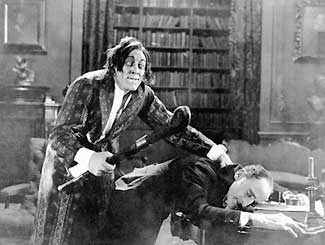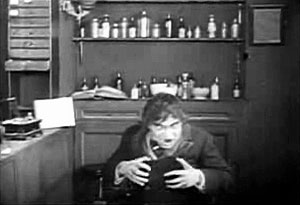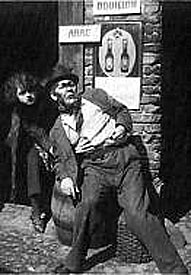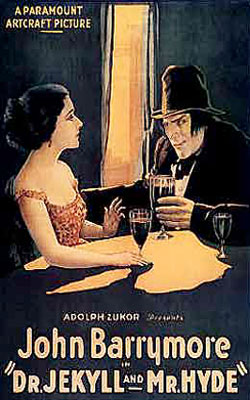 When one thinks of great & timeless silent horror films like Der Golem (1920), Nosferatu (1922), The Cabinet of Dr. Caligari (1920), Hands of Orlac (1924), or Korkarlen (1921), then John S. Robertson's take on Robert Louis Stevenson's classic tale, filmed about the same time as those greater pieces, simply pales to insignificance.
When one thinks of great & timeless silent horror films like Der Golem (1920), Nosferatu (1922), The Cabinet of Dr. Caligari (1920), Hands of Orlac (1924), or Korkarlen (1921), then John S. Robertson's take on Robert Louis Stevenson's classic tale, filmed about the same time as those greater pieces, simply pales to insignificance.
But as that list consists of European silent films exclusively, some would amend the claims for the 1920 version of Dr. Jekyll & Mr. Hyde in order to make it, if not a great silent horror film over all, nevertheless the first specifically American silent horror film of consequence. So, trivial in comparison to Phantom of the Opera (1925) because Phantom was not first.
And if I were to counter with the sentiment that Frankenstein (1910) is much better, the claim for John Barrymore as Jekyll & Hyde can be further amended as the first American full-length feature horror silent of consequence. It could go on like that a long time, special regulations to rule out the truly great in order to make a mediocre film look more important.
Were the 1920 silent version of Dr. Jekyll & Mr. Hyde the only thing a viewer knew of Barrymore's acting, he would be mistaken for a clownishly overacting fool in a piss-poor halloween costume dashed together by his blind granny.
The adaptation is a rough outline devoid of depth, devoid of visual charm, & of specialized interest only. The one exceptional scene is when Jekyll dreams of a giant spider, a very ghostly horror sequence, & Barrymore is in the spider costume.
 The 1911 short-short version tacked is more entertaining. It was twelve minutes, a two-reeler for the Nickleodeons, of which a little over eight minutes survive. A still is shown at left. The 1911 short-short version tacked is more entertaining. It was twelve minutes, a two-reeler for the Nickleodeons, of which a little over eight minutes survive. A still is shown at left.
Minimal though it is, the transformation FX are very nicely done, & James Cruze throws his all into the role. It takes its staging cues less from the 1886 novella than from an 1887 theatrical adaptation by Thomas Russell Sullivan.
Earlier versions of the Jekyll & Hyde tale begin with Otis Turner's Dr. Jekyll & Mr. Hyde (1908), a short film for the William N. Selig Polyscope Company, drawn from a stage play by George F. Fish, & starring Hobart Bosworth. It was well received in its day, & had a 1920 revival as A Modern Jekyll. Alas, no copies survive.
 The third film adaptation was the Danish quarter-hour film, Den skaebnesvangre opfindeise distributed in the US as Dr. Jekyll & Mr. Hyde; or, A Strange Case 1910), though the Danish title meant literally The Fatal Invention. Alwyn Neuss starred. The third film adaptation was the Danish quarter-hour film, Den skaebnesvangre opfindeise distributed in the US as Dr. Jekyll & Mr. Hyde; or, A Strange Case 1910), though the Danish title meant literally The Fatal Invention. Alwyn Neuss starred.
This 1910 version is also a lost film, though there remains hope it will turn up in one or another Scandinavian archive someday.
But Alwyn Neuss also starred in a German Vitaskop partially restored version which originally ran to five reels (nearly an hour). This is Ein Seltsamer Fall; aka, Sein eigner Morder (Dr. Jekyll & Mr. Hyde, 1914), filmed without Stevenson's permission.
About half the film (three reels, thirty-one minutes) survive, distributed through Filmmuseum Munchen. A still is reproduced at right,
There were several other versions of the silent film era, including parodies, some few surviving in whole or in part, though the majority just add to the litany of lost films.
copyright © by Paghat the Ratgirl
|


 The 1911 short-short version tacked is more entertaining. It was twelve minutes, a two-reeler for the Nickleodeons, of which a little over eight minutes survive. A still is shown at left.
The 1911 short-short version tacked is more entertaining. It was twelve minutes, a two-reeler for the Nickleodeons, of which a little over eight minutes survive. A still is shown at left. The third film adaptation was the Danish quarter-hour film, Den skaebnesvangre opfindeise distributed in the US as Dr. Jekyll & Mr. Hyde; or, A Strange Case 1910), though the Danish title meant literally The Fatal Invention. Alwyn Neuss starred.
The third film adaptation was the Danish quarter-hour film, Den skaebnesvangre opfindeise distributed in the US as Dr. Jekyll & Mr. Hyde; or, A Strange Case 1910), though the Danish title meant literally The Fatal Invention. Alwyn Neuss starred.